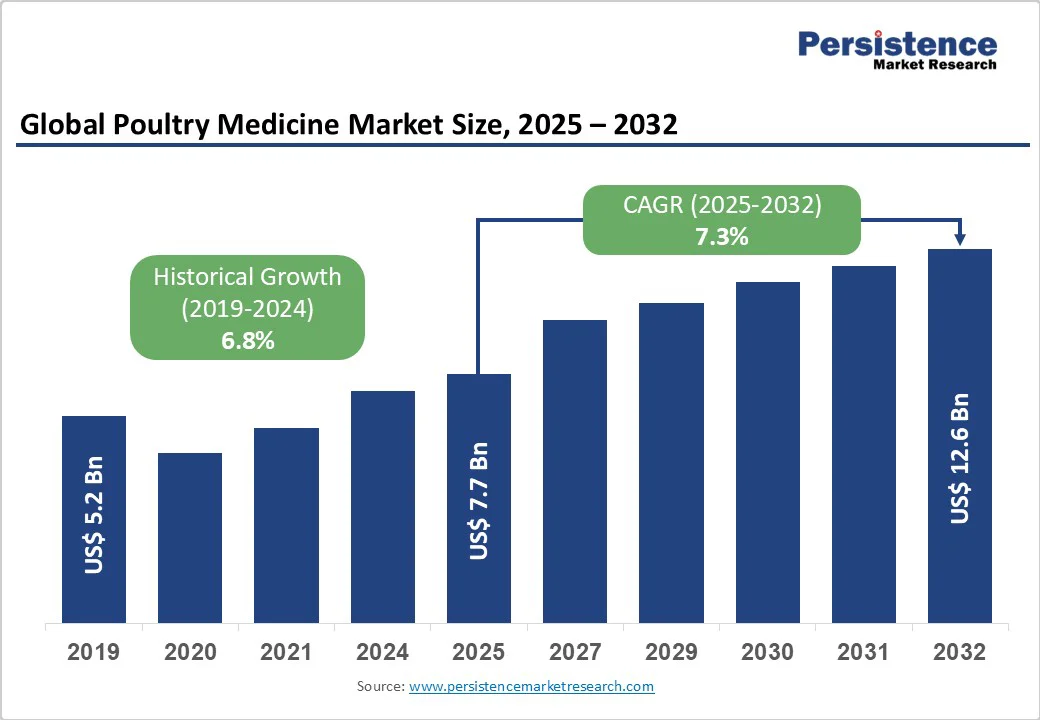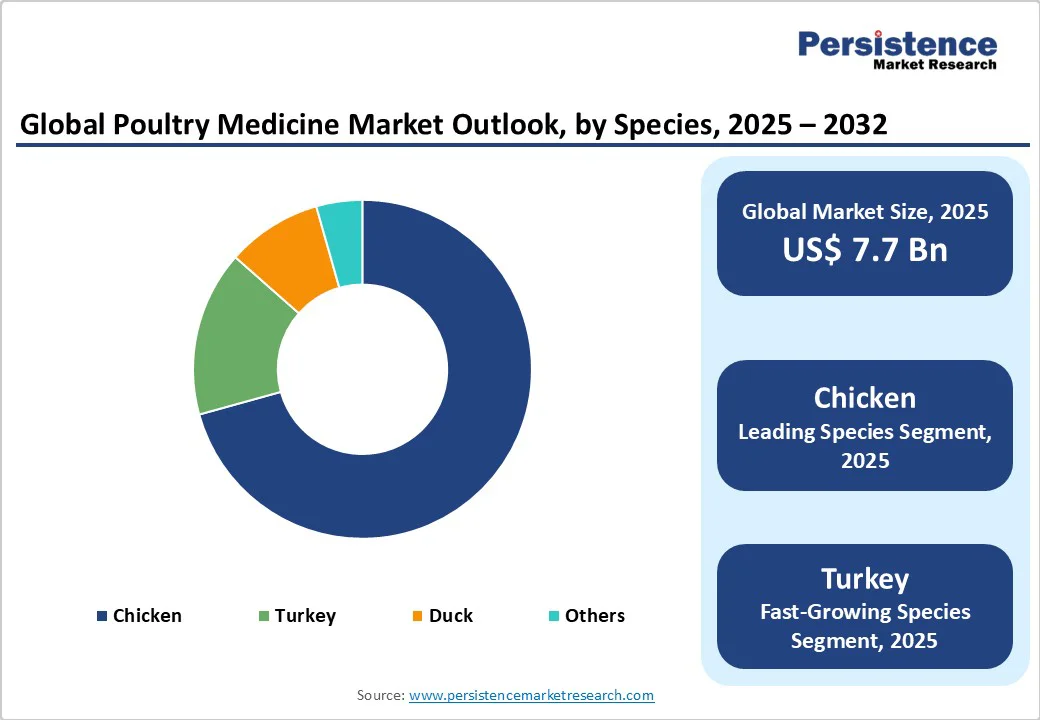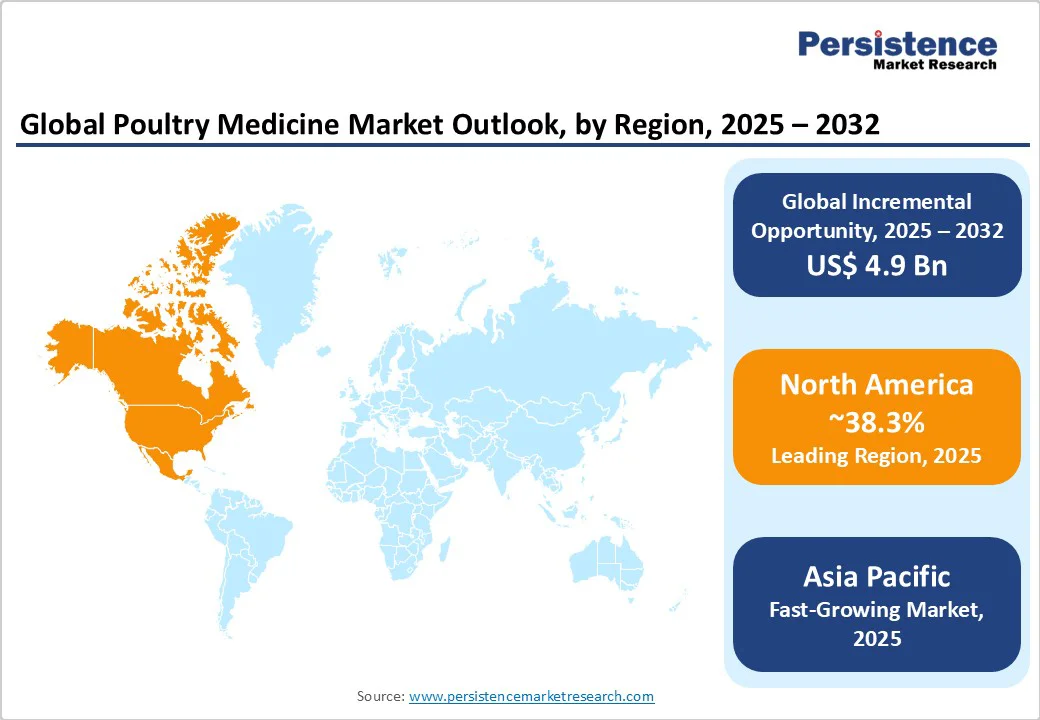ID: PMRREP35761| 183 Pages | 22 Oct 2025 | Format: PDF, Excel, PPT* | Healthcare

The global poultry medicine market size is likely to be valued at US$7.7 billion in 2025. It is estimated to reach US$12.6 billion in 2032, growing at a CAGR of 7.3% during the forecast period 2025 - 2032, driven by increasing prevalence of infectious diseases, including avian influenza, Newcastle disease, and infectious bronchitis. These are prompting farmers to adopt proactive health management strategies.
| Key Insights | Details |
|---|---|
| Poultry Medicine Market Size (2025E) | US$7.7 Bn |
| Market Value Forecast (2032F) | US$12.6 Bn |
| Projected Growth (CAGR 2025 to 2032) | 7.3% |
| Historical Market Growth (CAGR 2019 to 2024) | 6.8% |

The frequent occurrence of infectious diseases in poultry is a primary factor driving the expansion of the market. Outbreaks of avian influenza, Newcastle disease, and contagious bronchitis continue to threaten flock health, prompting farmers to adopt proactive measures to protect their flocks.
In 2025, Southeast Asia and Europe experienced several bird flu outbreaks, including highly pathogenic H5N1 strains in France and Vietnam, prompting mass vaccination campaigns and enhanced biosecurity measures. This high disease pressure increases demand for vaccines, antibiotics, immunomodulators, and diagnostic solutions, encouraging pharmaceutical companies to innovate and expand their product lines.
The surging consumer preference for poultry meat and eggs is another key driver. As global demand for affordable protein sources increases, poultry production is expanding, creating a corresponding need for health management solutions to maintain flock productivity.
For example, in 2025, North America and the Asia Pacific reported increased consumption of broiler meat and eggs, compelling producers to invest heavily in preventive care, vaccines, and nutritional supplements to minimize disease losses. This trend not only boosts sales of veterinary medicines but also encourages the development of heat-stable vaccines and nutraceuticals.
The increasing prevalence of antibiotic resistance is a key hurdle for poultry medicine. The overuse of antibiotics in poultry flocks has led to the emergence of resistant bacterial strains, thereby reducing the effectiveness of commonly used drugs and complicating disease management. This resistance not only threatens animal health but also poses risks to humans through the food chain, making regulatory authorities impose strict controls on antibiotic usage.
For instance, the European Union’s 2025 regulations now limit certain antibiotic classes in poultry feed to combat resistance, forcing companies to invest in alternative solutions such as vaccines and probiotics. Such regulatory pressure and the requirement for new interventions are slowing the quick adoption of conventional antibiotic-based therapies in poultry.
Prolonged exposure to residual antibiotics in poultry products, such as ciprofloxacin, can lead to long-term health complications in both humans and animals. These residues, often present due to incomplete withdrawal periods before slaughter, tend to contribute to toxicity, organ damage, and disruptions in gut microbiota.
Awareness of these risks has prompted stringent monitoring and testing requirements by agencies such as the U.S. FDA and European Medicines Agency, increasing compliance costs for poultry producers. Pharmaceutical companies are further pressured to develop safe alternatives, which can limit the use of conventional antibiotics and slow market growth.
Novel monitoring systems present a prominent growth opportunity for the market by enabling early detection of illnesses. Technologies now analyze audio signals from poultry houses to identify abnormal sounds such as coughing or sneezing, which are indicative of respiratory infections, including avian influenza or Newcastle disease.
AI-based platforms can alert farmers to potential outbreaks in real time, allowing for prompt intervention and reducing mortality rates. For example, recent trials in Southeast Asia using sound recognition algorithms have successfully predicted early-stage respiratory disease in broiler flocks, improving flock health management.
Biotechnological developments in feed formulation are emerging as a key growth opportunity. The use of microbial proteins in feed enhances nutrient absorption and gut health. At the same time, crystalline amino acids are incorporated to precisely balance the protein content precisely, ensuring optimal growth without overloading birds with unnecessary nutrients.
In 2025, several companies in the Asia Pacific and Europe launched amino-acid-fortified feed solutions that improve feed conversion ratios and reduce the risk of nutritional deficiencies. This creates opportunities for poultry medicine firms to expand into functional feed additives, probiotics, and complementary health supplements.
The chicken segment is expected to hold a share of approximately 70.7% in 2025, owing to its high feed-to-meat conversion efficiency, making it the most cost-effective source of animal protein worldwide. Its short production cycle allows farmers to quickly respond to consumer demand, which is essential in regions with rising meat consumption. Additionally, chickens are more resilient to varying farm conditions and require less space than other poultry, making large-scale production more feasible.
Turkey is experiencing considerable growth, as it is highly susceptible to respiratory and viral diseases, including avian influenza and turkey rhinotracheitis, which can result in significant economic losses. Its longer growth cycle compared to chickens makes disease prevention and health management crucial for maintaining profitability. Turkeys are also a staple in seasonal and festive markets, mainly in North America and Europe, where demand peaks during holidays such as Thanksgiving and Christmas.
Pharmaceuticals are expected to account for a share of nearly 68.6% in 2025, backed by their proven efficacy, accessibility, and versatility in managing a wide range of bacterial, viral, and parasitic infections. Antibiotics, anti-inflammatories, and other chemical formulations can quickly control disease outbreaks, which is essential in large-scale poultry operations where even small losses can have significant economic impacts.
Biologics are anticipated to exhibit a decent CAGR in the foreseeable future, driven by increasing regulatory restrictions on antibiotics and rising consumer demand for antibiotic-free poultry products. These products focus on preventing diseases rather than treating them after they have occurred, thereby improving flock health and reducing mortality rates. Additionally, advancements in recombinant vaccines and needle-free delivery systems are anticipated to drive demand.
Newcastle disease is estimated to capture a share of around 23.9% in 2025, backed by its high contagiousness and the severe economic impact it causes on poultry farms worldwide. The virus can spread quickly through direct contact, airborne particles, and contaminated equipment, affecting both chickens and turkeys. Its outbreaks can result in high mortality rates and significant production losses if not promptly managed. The continuous evolution of virus strains also keeps demand high for updated vaccines and treatment protocols.
Infectious Bronchitis (IB) is expected to increase significantly due to its impact on respiratory health and egg production in poultry, particularly in commercial layer flocks. The virus reduces egg quality and laying efficiency, creating ongoing economic challenges that necessitate continuous vaccination and preventive measures. In 2025, AI-based monitoring systems in China and India successfully detected early signs of IB through abnormal coughing patterns in flocks, allowing timely interventions.

In 2025, North America is projected to account for nearly 38.3% of the market share, driven by technological advancements, regulatory changes, and shifting consumer expectations. Emerging technologies are transforming poultry health management. In California, a novel H5N9 bird flu strain prompted the culling of nearly 119,000 birds, underscoring the need for targeted disease control measures.
Companies such as Zoetis have hence developed thermostable vaccines, including the H5N1 vaccine for chickens, which received conditional approval from the USDA in early 2025. The U.S. Department of Agriculture has further proposed making high processing speeds permanent, allowing chicken plants to process up to 175 birds per minute. Consumer demand for ethically produced poultry products is influencing industry standards.
Aisa Pacific is currently grappling with a resurgence of avian influenza, notably the H5N1 strain, which has led to increased human infections in Cambodia, China, and Vietnam. The UN's Food and Agriculture Organization has urged urgent and coordinated responses to combat the rise in bird flu cases, emphasizing the requirement for comprehensive surveillance and biosafety measures.
Government bodies are hence implementing extensive vaccination campaigns. For instance, Indonesia and the Philippines are improving biosecurity protocols and vaccination coverage to mitigate the spread of avian influenza. These efforts are bolstered by the increasing acceptance of vaccines targeting common avian diseases such as Marek's Disease and Newcastle Disease.
The resurgence of avian influenza remains a key concern across Europe. In October 2025, France reported a new outbreak of highly pathogenic avian influenza on a pheasant and partridge breeding farm in northern France. In response, authorities announced that the farm's entire flock would be culled, and poultry within a 10-kilometer radius would be required to be kept indoors to contain the spread. This comes amid a seasonal increase in bird flu cases across Europe, raising concerns over potential human transmission.
To combat these outbreaks, several European countries are implementing vaccination campaigns. France, for instance, has initiated its third annual bird flu vaccination campaign, focusing on farm ducks, a strategy that the government says has been effective in controlling outbreaks. The Netherlands has also started a pilot program to vaccinate poultry against bird flu, beginning with a laying-hen farm. This move aims to pave the way for widespread poultry vaccination in response to the highly pathogenic avian influenza.

The global poultry medicine market consists of both global pharmaceutical giants and regional players. Leading players, including Zoetis, Merck Animal Health, and Boehringer Ingelheim, dominate the market with a broad portfolio of vaccines, antibiotics, and diagnostics.
They are using technological developments and regulatory approvals to maintain their market positions. In India, companies such as Hester Biosciences and Venky's India have established superior footholds by catering to local poultry health requirements and complying with regional regulations.
The poultry medicine market is projected to reach US$7.7 Billion in 2025.
Rising disease outbreaks and high global demand for poultry products are the key market drivers.
The poultry medicine market is poised to witness a CAGR of 7.3% from 2025 to 2032.
The development of biologics and the launch of real-time monitoring systems are the key market opportunities.
Boehringer Ingelheim International GmbH, Merck & Co., Inc., and Vaxxinova International BV are a few key market players.
| Report Attribute | Details |
|---|---|
| Historical Data/Actuals | 2019 - 2024 |
| Forecast Period | 2025 - 2032 |
| Market Analysis | Value: US$ Bn |
| Geographical Coverage |
|
| Segmental Coverage |
|
| Competitive Analysis |
|
| Report Highlights |
|
By Species
By Product Type
By Disease
By Region
Delivery Timelines
For more information on this report and its delivery timelines please get in touch with our sales team.
About Author